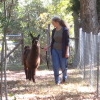

| Online: | |
| Visits: | |
| Stories: |

| Story Views | |
| Now: | |
| Last Hour: | |
| Last 24 Hours: | |
| Total: | |
Baking With Wood Ash? (Part 1)
Now that Critter Tales is behind me, I'm turning my hand to working on more volumes for my The Little Series of Homestead How-Tos eBook series. Yes, I know that sounds like it contradicts my New Year goal of going hard-copy for information I don't want to lose. From a writers' perspective, however, eBooks (like my blog) give me a chance to get something published, get feedback, and edit them later. My eventual goal (Good Lord willing and the creeks don't rise) is to compile the series into a paperback. The one I'm working on at present is “How To Bake Without Baking Powder.”
When we think of baking without commercial baking powder, recipes for homemade baking powder come to mind. So do old-fashioned recipes calling for saleratus and sour milk or buttermilk. All of these work on the same chemical principle: an acid + a base = carbon dioxide bubbles which cause a batter to rise. While doing my research, I ran across an interesting statement in a Wikipedia article.
“In times past, when chemically manufactured baking soda was not available, “ash water” was used instead. Ashes from hardwood trees contain carbonates and bicarbonate salts, which can be extracted with water. This approach became obsolete with the availability of purified baking soda.”
How could I not resist following up on that?
I know ashes in one's food probably sounds gross, but consider that wood ashes have been used historically in cooking worldwide: in Mexico for nixtamalization of corn for masa, in the Philippines as Lihia, in Nigerian cuisine as Kaun or Akaun (Cooking Potash), in traditional Scandinavian foods like lutefisk (lye fish), for making olives in the Mediterranean, in old European recipes for Greek and Polish cookies, as Pottasche for browning German pretzels and lye rolls, in gingerbread, in Chinese Century eggs and noodles. Native Americans also used wood ash to make hominy. Cooking with ash is considered a trendy gourmet technique, and think of ash-coated cheeses. Or how about this paleo recipe for steak cooked on a coal bed?
All of that might not convince you, but the prepper in me is always running in the background asking, “How would I do that if I couldn't buy or barter for it?” In this case, “How would I bake quickbreads if I couldn't get baking soda? Could I somehow use hardwood ashes if I had to?”
There were no references for that tidbit at Wikipedia, so I had to do a little digging on my own. In his blog post ”Where does soda bread come from?,” Joe Pastry mentions that Native Americans used ashes to “lighten” their grain cakes. Susan Slack (“Pearl Ash – A forerunner to Baking Soda“) further states that the Hopi made a thin batter of blue corn meal, wood ash, and water to make piki, their staple bread.
In terms of actual recipes, the earliest references I could find did not call for wood ash proper, but rather for potash. Potash is a product which is refined from hardwood ash. It was in use in American cookery in the 1700s. Example proportions are found in an old “American Potash Cakes” recipe in The Domestic Encyclopedia, Or, A Dictionary Of Facts And Useful Knowledge, Chiefly Applicable To Rural & Domestic Economy: With An Appendix, … And The Veterinary And Culinary Arts… (published in 1802): a half-teaspoon potash dissolved in a half-teacupful of water to 1 pound flour (about 4 cups) and a quarter pound of butter (1/2 cup).
In Martha Washington's Booke of Cookery and Booke of Sweetmeats, transcriber Karen Hess states, “that American women were routinely using this chemical (made at home of wood ash) in their baking,” (page 201). She is referring to pearl ash (or pearlash), but gives no clue as to how it was made at home.
Pearlash (potassium carbonate) is a purified form of potash. It is sometimes found in recipes of the American Civil War era and before. The modern leavener of the time, however, was saleratus (Latin for aerated salt). Chemists had discovered that by exposing potassium carbonate (pearlash) to carbon dioxide gas, they could make potassium bicarbonate. It was twice as potent as pearlash, with one teaspoon of saleratus being equivalent to 1-1/4 teaspoons of baking soda.
In the mid-1800s a purer form came onto the market – sodium bicarbonate. Originally developed in Europe, the first American manufacturers of sodium bicarbonate also called it saleratus. Later it became known as baking soda.
Okay, so the history is interesting, but how can I, as a DIYer, use that information? By experimenting! More on that coming soon in part 2.
Source: http://www.5acresandadream.com/2016/01/baking-with-wood-ash-part-1.html


